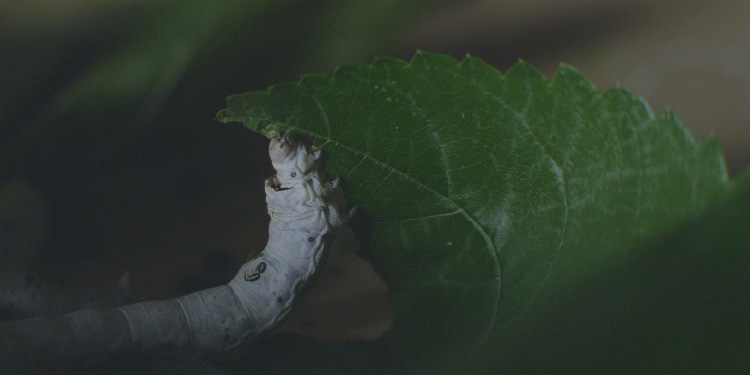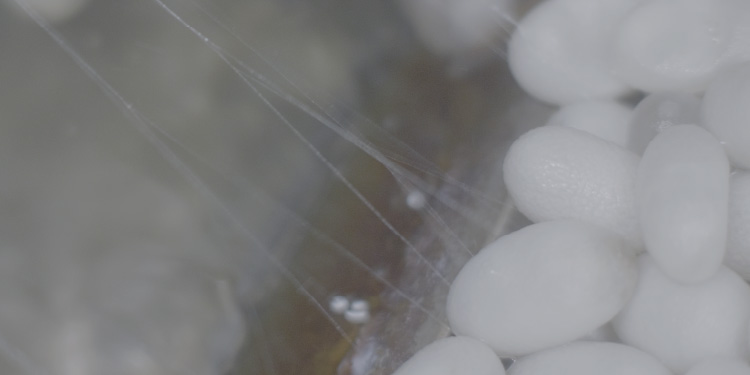

Life is sustained from life. Just how much do we fail to recollect this truth as we go about our lives? The food we eat and the clothes we dress ourselves in today have been given to us from a great many lives.


Silk is made from the cocoons of silkworms. Silkworms are said to have gotten their name after people started raising the wild silk moth (Bombyx mandarina), which eats mulberry leaves. Silkworms were first domesticated 5,000 years ago in China and were brought to Japan during the Yayoi Period (c. 300 bce–c. 250 ce). The technology to create silk thread from high-quality cocoons was established in Japan during the Edo Period (1603–1867).
Many farming families used to live together with the silkworms that they raised in the attic loft of their home. They say that in the quiet of the night, the sound of larvae eating mulberry leaves could be heard through the ceiling, like the sound of soft rain falling.
We’re going to take a trip following silk—this fiber that is at once familiar and yet unknown. This is a trip that touches on the origins of life. Here, a great many human endeavors connecting the past to the present are bound together by a single thread.


We're in the Shonai region of Yamagata Prefecture. Beautiful rice fields extend before us on a fertile plain as far as the eye can see. The Sakai clan, an important vassal family loyal to the Tokugawa shogunate, ruled this area in the Edo Period. The lives of the feudal lord, his retainers and the citizen folk of the domain were deeply intertwined. Even today, the head of the clan lives next to the former site of Tsurugaoka Castle and is referred to as “the lord" by many citizens, who hold him in high regard.
The samurai of the Shonai Domain fought valiantly on the side of the shogunate during the Boshin War (the 1868–1869 civil war fought in Japan), but after the war they were branded rebels. They put down their swords and took up hoes as a way to dispel this dishonor. They cleared a vast pine forest to create mulberry orchards and built a number of buildings for raising silkworms. Silk exports were substantially responsible for the “enriching the country" part of the “Enrich the country, strengthen the army" (fukoku kyohei) slogan that defined the Meiji Period (1868–1912). At the vanguard of this endeavor were the samurai of Shonai.
Flash forward 150 years. The Japanese silk industry, unable to compete against the invention of synthetic textiles and inexpensive mass-produced products from China and Brazil, has almost disappeared domestically. Raising silkworms and harvesting their fibers for thread, weaving the thread into cloth, softening it through refining, dyeing it gorgeous colors and then fabricating silk garments—Tsuruoka is now the only place left in Japan where all of these processes still take place. Why have people persevered in continuing this craft even today despite the extraordinary challenges they face?
According to Kyosuke Yamato of Tsuruoka Silk, it comes from “a desire to carry on the aspirations of my predecessors." Silk production involves many processes that cannot be done by one enterprise alone. The spirit of “everyone helping each other" taught at Chidokan, the domain-based school that formerly operated in Tsuruoka, is still alive today.
He showed us the process of silk reeling, where silk fibers are harvested from cocoons. When cocoons are placed in hot water and brushed with a straw brush, fibers on the outside of the cocoon loosen and come off. As the cocoons spin around, the fibers are wound around a spool to create silk thread with a lustrous milky white color.
Looking in the water, we could see small pupae showing through inside the cocoons, which had become thinner and more transparent. One cocoon contains one life. This self-evident fact hit us with a sudden urgency. One bolt of silk kimono fabric is woven from some 3,200 silkworm lives.


The food we eat and the clothes we dress ourselves in today have been given to us from a great many lives. The same holds true for both plants and animals. Life is sustained from life. With this thought in mind, we should use things for as long as we can without waste. Like we put our hands together and say itadakimasu before we eat to express our gratitude, we should also offer thanks from our hearts when we put on our clohtes, with our feeling of gratitude blooming like flowers of remembrance for the predecessors who passed down their work and the craftspeople who are creating the products today, down to the chain of life contained in a single thread.
職種:店舗販売 / 営業 / 生産管理 / パタンナー / デザイナー
正社員登用、給与は経験により相談。月20万円以上。
年齢性別不問。
厚生年金、健康保険、雇用保険等完備。交通費支給、賞与。
ご希望の方は、メールにて履歴書と職務経歴書をお送り下さい。
通過者のみ面接の返信をいたします。なお募集の職種は時期によって異なる場合があるのでお問い合わせください。
*学生のインターンは随時可能ですので、希望者は面接いたします。
送信先メールアドレス:matohu@lewsten.com
◇ matohuの理念
「日本の美意識が通底する新しい服の創造」をコンセプトに文化や歴史を大切にしながら、現代人の心に響く魅力ある「デザイン」を生み出すこと。それを深い「言葉」で表現し、共感者の輪を拡げて行く「場」を作って行くこと。
この3つを通して、多様で心豊かな世界をともに作り上げることがmatohuのプロジェクトであり、理念です。
◇ 仕事のやりがいと人間的成長
まかされた仕事を自分の創意で工夫していける環境です。1Fはショップ、2Fはアトリエになっており、デザイナーと直接話しながらアイデアを実現していけます。また文化、歴史など幅広い知識を学ぶ機会も多く大人の教養と礼儀が身につき、人間的にも成長できます。
人の心に彩りを添えるデザインを生活のなかに!を合い言葉にこれから世界に向けて発信するmatohuのスタッフを募集します。